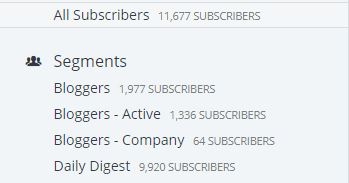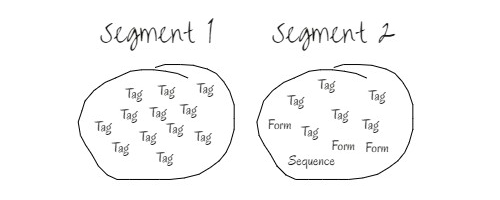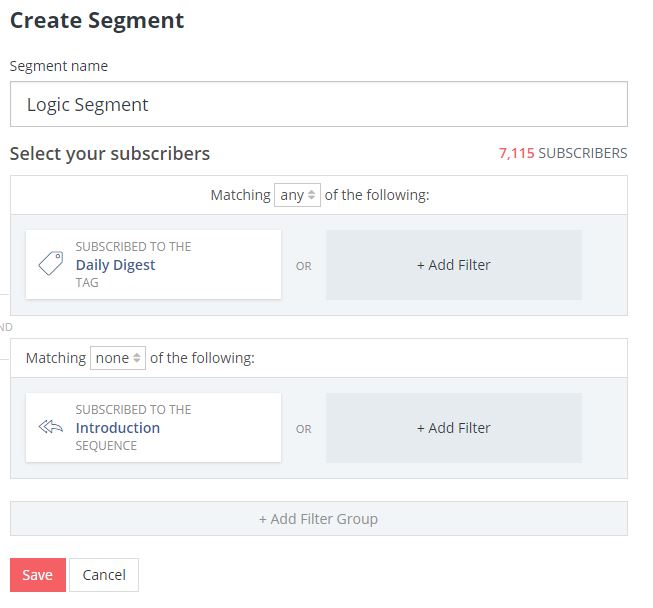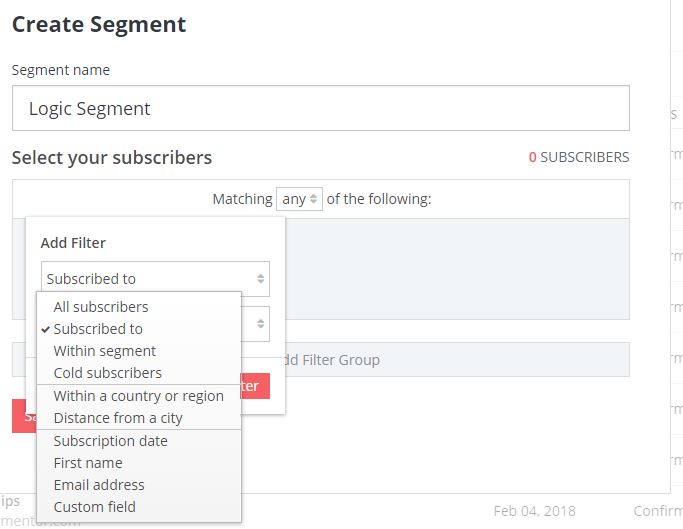Do you remember when the DVR (Digital Video Recorder) came out for TV subscriptions? A lot of us have them, and DVRs let us skip commercial breaks and automatically record the television programs that we care the most about. It was a total game-changer for TV watchers.
And, tagging and segmenting our email subscribers changed the digital marketing game in very much the same way. Though we aren’t skipping content, here. Instead, they give us bloggers the power to organize our email subscribers into groups.
These groups link together subscribers with similar interests or actions.
Groups possess incredible power. Smart bloggers use those groups to send targeted emails to those subscribers who are most likely to care.
Before we get into how to exploit the power of these tag and segment groups, let’s start at the beginning and discuss the difference between a tag and a segment.
 For the record, I’m a huge fan of ConvertKit. ConvertKit is one of the most capable (and well-designed) email marketing providers that supports the ability to tag and segment email subscribers quickly and easily.
For the record, I’m a huge fan of ConvertKit. ConvertKit is one of the most capable (and well-designed) email marketing providers that supports the ability to tag and segment email subscribers quickly and easily.
I am going to use ConvertKit to help demonstrate tags and segments in this article. If you don’t have a ConvertKit account, do yourself a favor and check them out.
What are email tags and segments?
Both tags and segments accomplish a similar goal, but their structure is different. And since we’re all bloggers around here, I’m going to compare tags and segments in email marketing to tags and categories in blogging.
That is:
- Email marketing tags work exactly the same way as blog post tags
- Email marketing segments are very similar to blog post categories
ConvertKit explains the difference between tags and segments like this:
“Tags organize subscribers and segments organize tags.”
Visualize it like this:

Segments contain tags. They also contain forms, sequences and other subscriber properties (like location, subscription date, last action, etc). They can even contain other segments.
Your subscribers can belong to more than one tag as well as segment. If this sounds confusing, that’s because it is – at first. But, it’s this capability that provides so much power and flexibility with email marketing. Once you get used to it, it’s easy.
Love it. Okay, we’ll discuss tags first.
Email marketing tags
In short, think of an email marketing tag like you would a tag in WordPress. When you’re writing a post, you might tag that post with a bit of identifying information. This information helps us to keep track of our subscribers and what they are doing.
I’m sure we’re all familiar with the tags textbox within WordPress.

With email, tags are commonly used to track email subscribers in several ways:
- When they buy a product, they are tagged as a customer
- When they click on a link, they are tagged with an interest
- Tagged with preferences, like email frequency (ie: digest vs, daily emails)
Most email marketing providers that support tags allow an unlimited number of tags to be used, including ConvertKit. Like in WordPress, tags can be used for virtually any purpose. That part is entirely up to us bloggers.
However, there are a few tips to help you get the most out of email tags.
Tips for creating effective email marketing tags:
- Pick a descriptive name for each tag so you know what they do (for example, instead of “Tag 1”, use “Daily Digest” or “Clicked Product A Link”)
- Use Link Triggers to automatically tag subscribers
- Use tags consistently
Email marketing segments
A segment is analogous to a category on your blog. In email marketing, it’s a collection of tags. On your blog, it’s a collection of closely related blog posts.
Each post in the category might be tagged as well. That’s okay.
Segments, much like blog categories, work at a higher level.
Let’s take a look at an example of how segments work.
Pretend that you’re blogging about automobiles (aka: you run a car blog). You’re writing about different cars, their capabilities, news, latest technology, etc.
You might tag each post with lower-level descriptive tags like “Mazda” or “Ferarri”. Or, maybe you’ll use tags to track certain capabilities of the cars, like “Cruise Control” or “Self-Driving”.
You might have 30 or 40 tags created for your car blog scattered among your posts.
With me?
Okay, now, how can we further categorize these blog posts into higher-level groups like “race cars” or “luxury”? This is where segments come into play.
A “race car” category might contain all posts written about – you guessed it, race cars. But, each car post also possesses a collection of other tags, like “self-driving” or “V-8”, “6-Speed”, “5-Speed”, “Cummins”, “Duramax”, etc.
Blog categories contain posts. Posts contain tags.
Email segments contain tags and tags contain subscribers.
While tags track specific characteristics of your subscribers, segments track who they are. In other words, segments group subscribers into collections at a higher level.
How are tags and segments typically used?
Tags and segments are used to create groups of email subscribers that are similar in some way. Then, emails can be personalized and sent to subscribers of specific tags or segments. This very often increases email open rates.
For example, let’s say that you’ve developed three different products: Product A, Product B, and Product C. It’s typical to add your customers/readers to your email list each time they sign up for one of your products.
Whenever a reader signs up for Product A, they are tagged with “Product A”. The same thing happens whenever someone signs up for Product B and Product C.
Here’s a simple scenario with some numbers that will help demonstrate how bloggers can use tags and segments to get the most out of email marketing.
You have the following tags (with subscriber count) in your email provider:
- Product A (53)
- Product B (25)
- Product C (13)
In other words, 53 people have signed up for Product A, 25 for B and 13 for C.
Already, this provides a ton of power. If we release an update for one of our products, we can easily notify the right customers by emailing just those subscribers within the appropriate tag.
Where do segments come into play? Using this scenario, a segment could be as simple as “Customers”, and the segment contains everybody within our three Product tags.
For example:
- Customers (91) <– Our segment
- Product A (53) <– A tag
- Product B (25) <– A tag
- Product C (13) <– A tag
Note: The “Customers” segment describes who these subscribers are at a higher level. And, each tag indicates exactly what products they’ve signed up for. Tags contain lower-level characteristics of each subscriber within the tag.
Now, we’ve uncovered more power. By segmenting all of our customers (in this example, it’s 91 total subscribers), we can not only view all of our customers in one spot but also email them with additional offers that they might be interested in because they’ve already signed up for one of our products.
This is the secret sauce to successful email marketing. It’s about getting the right email into the right inbox. Tags and segments provide this power.
Contrast this with NO tags or segments. If we were to send an email to our entire email list with product updates, for example, we’d almost definitely lose subscribers.
Why?
Because the majority of our subscribers won’t care. If they didn’t sign up for Product A, they don’t care about updates to Product A.

Though there are exceptions, broadcast emails are very commonly sent to segments of subscribers (rather than subscribers of tags, forms or sequences).
The power of email segmentation
This was a relatively simple example. The power of email segmentation doesn’t stop there. Segments can get pretty complex.
For example, take a look at this segment below in ConvertKit.

We have multiple criteria in play. This segment will contain all email subscribers who are subscribed to the “Daily Digest” tag but have NOT taken the “Introduction” sequence.
And ConvertKit will tell you, in red and on the fly, exactly how many subscribers will be in the segment above the form (in this case, 7,115).
That’s pretty cool, eh?
There is a slew of different criteria that can help bloggers segment out their email subscribers in powerful, yet meaningful, ways.
Check out all the filters available to segments in ConvertKit:

How I use tags and segments
On one of my other blogs, I send out several emails. Some of my subscribers like on-the-fly emails immediately after I publish a new post. Other subscribers would rather receive a single weekly digest.
I have three segments that capture this level of detail:
- Daily Subscribers
- Weekly Subscribers
- All Subscribers (contains Daily Subscribers and Weekly Subscribers)
Notice that segments can contain other segments. In the above example, my ‘All Subscribers’ segment contains both the Daily Subscribers and Weekly Subscribers segments.
My Daily Subscribers segment gets emails every time I publish a new post. My Weekly Subscribers only get a single email once a week. Any time that I need to email my entire email list (regardless of their email frequency preference), I use ‘All Subscribers.
It’s quick, easy, and effective.





